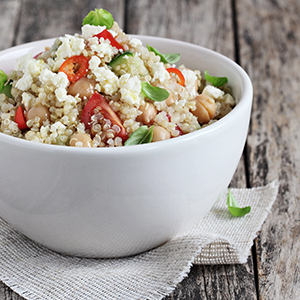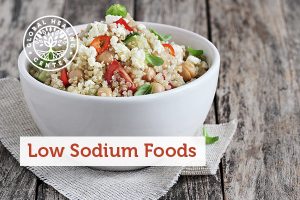

When people talk about sodium, they usually mean table salt — technically, sodium chloride. Around the world, people use salt to add flavor and verve to savory dishes. We eat salt because the body requires it to send nerve impulses from the brain to the body, enable muscle contraction, and act as an electrolyte, regulating your blood pressure and blood volume.
However, most people get too much salt. Your physician or dietitian may have told you to lower your sodium intake to bring your blood pressure under control, or you may want to limit salt intake to counteract health problems. The body requires less than 500 milligrams of dietary sodium daily for good health, yet most Americans consume 3,400 milligrams per day! Many foods have strong, vibrant flavor without needing additional salt to enhance their taste, and here we share the best options.
What Is Sodium & Why Do We Need It?
Sodium is a mineral we need to survive. Along with potassium, magnesium, and chloride, sodium is an electrolyte, a substance in our blood that sparks a small electric charge to help our body to function normally.
The kidneys regulate sodium levels in your body. When sodium levels rise too high, your body retains water, you gain weight, and your skin may look puffy. Water retention due to elevated sodium increases the amount of fluid in your blood, which means you have a higher blood volume. This, in turn, raises your blood pressure — the force of blood pushing against the walls of your arteries — which strains the heart.
The Best Low-Sodium Foods
According to the U.S. Centers for Disease Control and Prevention (CDC), low-sodium foods are those with less than 140 milligrams per serving. Moderate-sodium foods have between 140 and 400 milligrams per serving, and high-sodium foods contain more than 400 milligrams per serving.
The best low-sodium foods are natural, whole foods: vegetables, fruits, nuts, seeds, and grains. A medium banana or a handful of walnuts has only 1 milligram of sodium, a cup of dried lentils contains 4 milligrams, and half an avocado has 10 milligrams.
At Global Healing Center, we recommend you follow a plant-based diet for optimal health, avoiding meat and animal products. According to research by the National Institutes of Health, people who eat vegetarian diets have lower mortality rates.[1] Vegetarian and vegan diets are typically full of nutrient-dense foods and high in fiber, and, as a result, are associated with lower rates of cancer, cardiovascular disease, diabetes, and kidney disorders.[1]
There are lower-sodium options within all the food groups. With packaged foods, always check the label as different brands have different sodium levels for the same foods. Here are your best low-sodium choices.
Fruits & Vegetables
- Fresh, frozen, or no-salt-added canned vegetables, such as broccoli, carrots, eggplant, peppers, potatoes, and kale
- Fresh, frozen, or dried fruit, such as apples, oranges, grapes, pineapples, and bananas
Protein
- Beans, peas, and legumes such as kidney beans, black beans, chickpeas, lentils — dried, frozen, or low-sodium canned
- Unsalted nuts
- Seeds (no salt added) including chia, pumpkin, or sunflower
- If you eat dairy, choose low-sodium, unpasteurized cheeses.
- If you eat meat such as beef or chicken, select fresh cuts prepared without salt or sauces.
- If you eat fish, only buy fresh cuts of fish and shellfish, avoid canned
Fats
- Extra virgin olive oil (EVOO)
- Coconut oil
- Non-GMO vegetable oils like sunflower, peanut, avocado
Grains
- Whole grains such as quinoa, barley, and oats
- Wild or brown rice
- On whole-grain pasta, bread, or tortillas (check the food labels)
Condiments, Snacks, and Sweets
- Use oil and vinegar, lemon/lime juice, or low-sodium dressing on your salad
- Use all-natural herbs and spices such as garlic, turmeric, rosemary, and ginger (check labels on herb mixes that may add sodium)
- Look for low-sodium versions of ketchup, mustard, salsa, and other condiments
- Low-sodium desserts include fruit sorbet and plain dark chocolate
- Yogurt and ice cream may be low-sodium foods; opt for non-dairy options
Benefits of Low Sodium Foods
As you can see, many naturally low-sodium foods are vegetables, fruits, beans, nuts, and seeds — the same healthful foods we generally recommend for best health. These choices are not only low in sodium, but also excellent sources of vitamins and minerals, fiber, and health-protecting antioxidants. In contrast, junk foods often contain high levels of sodium, as well as fats and sugars.
By following a low-sodium diet, you will improve your health in several ways. A lower sodium diet will help regulate your blood pressure and fluid levels, support better muscle and nerve function, and maintain kidney health.
Cutting extra salt out of your diet can help your body heal itself. Reducing sodium reduces your risk of developing cardiovascular disease. Research shows that when people reduce their salt intake, blood pressure drops within a few weeks, especially for people with hypertension.[2]
High Sodium Foods to Avoid
Most of our dietary sodium does not come from the shaker but hides in our food — especially processed and packaged foods. There are many high-sodium foods, but if you can cut back in a few key categories and avoid specific “bad guys," it will reduce your overall sodium intake.[3]
Some high-sodium foods — like soy sauce and olives — taste salty, but not all high-sodium foods do. Any processed food likely has added sodium (as well as sugar, but that's another article). Some frozen meals contain a full day's allowance of sodium in a single serving. While some varieties of sauerkraut are a great source of probiotics, some types of sauerkraut and other marinated vegetables are very high in sodium. Another reason to always check the nutritional facts label!
If you're trying to reduce your dietary sodium, steer clear of these items:[4]
- Most canned soup, meat, vegetables, and beans that do not specify "low sodium"
- Frozen entrees (TV dinners)
- Tomato juice
- Baked goods such as muffins, pastries, donuts, croissants
- Soy, teriyaki, barbecue, spaghetti sauces or sauce packets
- Packaged meal items such as scalloped potatoes, rice mixes, noodle mixes, stuffing
- Boxed breakfast items like pancake mix or instant hot cereals
- Most bread and rolls
- Fried foods
- Most cheese
- Cookies or cakes with trans fats
- Processed meat
- Prepared sandwiches, burritos, tacos, pizza
- Savory snacks such as chips, crackers, pretzels, and movie popcorn
- Chicken (often injected with salt brine)
Upper Daily Sodium Intake for Men and Women
The American Heart Association (AHA) recommends adult men and women consume no more than 2,300 milligrams of sodium per day, which is approximately one teaspoon of salt. AHA says that an even better limit for sodium is 1,500 milligrams daily.[5] Note, this is a safe upper limit, not a recommended daily value (DV). If you have a specific health condition, your healthcare provider may suggest that you lower your sodium even further.
Tips for Cutting Sodium in Your Diet
Your first step? Remove the salt shaker from your table and replace it with a sodium-free herb mix. Next, try these changes to your routines.
Shopping
- Go straight to the produce section, fill your cart with as many vegetables and fruits as you can eat. In particular, load up on foods high in potassium like spinach, potatoes, bananas, citrus fruits, and dried beans. Decreasing sodium combined with increasing potassium has been found to help control hypertension.[5]
- Steer your cart away from convenience foods and the bakery aisle.
- Look for items with the words "no salt added" or "reduced (or low) sodium."
- Check each foods Nutrition Facts label to figure out the amount of sodium in a serving. Commercial products are required to bear these labels, although grocery-prepared foods might not. Choose foods with less than 140 milligrams of sodium per serving.
- Read the list of ingredients. Skip those that contain salt, brine, monosodium glutamate, and soy sauce.
- Get familiar with the sodium counts of your favorite foods. If they're on the high side, eat smaller portions.
Eating Out
- Minimize the number of times you go out for dinner, cook at home instead. Avoid fast food entirely.
- When you dine at restaurants, order baked, grilled, or steamed entrees without sauces. Skip soups and anything that's breaded or fried.
- Bring a small container of your own low-sodium salad dressing.
- Many restaurant chains post nutrition information on their menu, so check before ordering or ask your server.
Cooking & Low-Sodium Recipes
- Preparing meals at home gives you more control over your diet's sodium content. Dine in more than you dine out.
- Center meals around low-sodium ingredients.
- Remove salt (including sodium-containing spice blends such as garlic salt) from your favorite recipes. Salt can be cut from any recipe unless it contains yeast.
- Season food with purchased or home-made no-sodium herb and spice blends. (Avoid "seasoning packets" such as those for tacos.)
- Prepare some of the delicious recipes on the Global Healing Center website — but omit any salt from them. Buddha bowl, anyone?
Points to Remember
It's important to reduce the amount of sodium in your diet if you have high blood pressure or heart conditions. Lowering your sodium intake helps reduce your risk of heart attack and stroke. Some people may want to limit sodium intake for preventative reasons, as well.
Aim to keep your levels at less than 1,500 milligrams/day. You can do this by eliminating table salt and choosing lower-sodium options from all the food groups. Foods with 140 milligrams per serving or less are considered low in sodium.
Plant-based foods are naturally low in sodium and should form the backbone of your low-sodium diet. When you buy packaged foods, read the label: make sure it says "low sodium," or "no added salt" and be aware of the sodium content per serving.
Knowing the top foods to avoid can keep your low-sodium diet on track: These include bread and rolls, cheese, processed meats such as bacon, and canned soups and frozen entrees. Steer clear of fast-food. Cook at home as often as possible to control the amount of sodium in each meal. You'll soon find that salt isn't necessary for a great meal when you add herbs, spices, and the savory flavor and texture of plant foods to your recipes.
The post Low-Sodium Foods: Best Choices & What to Avoid appeared first on Dr. Group's Healthy Living Articles.
source https://www.globalhealingcenter.com/natural-health/low-sodium-foods/
No comments:
Post a Comment